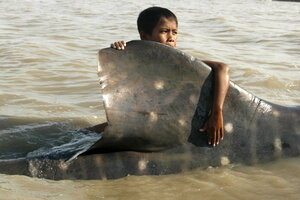A quarter of the world's sharks and rays now threatened with extinction, say scientists
Overfishing threatens to extinguish one in four of the world's cartilaginous fish species, according to new research.

An Indonesian youth clings to the dorsal fin of a beached whale shark as fishermen prepare to pull it back to the sea in East Java, Indonesia, in 2013. A new study reveals that one in four cartilaginous fish are threatened with extinction.
Trisnadi/AP
Sharks and rays may look like visitors from prehistory, but they behave like humans in one surprising way: they invest a lot of energy into just a few children. And thanks in part to their parenting style, many of these species may not survive the human fishing industry.
One quarter of all the world's cartilaginous fish species – known as chondrichthyans – are now threatened, reports a study published Tuesday in the journal eLife. The class includes sharks and rays, as well as chimaeras such as the little-studied but impressively serrated sawfish, which is now critically endangered.
"Because of their rarity, and the fact that [sawfish] had no particular commercial or sport-fishing value, studies on them were largely non-existent," says George Burgess, an ichthyologist who co-authored the report. "Unfortunately we, as scientists, work on a largely economic basis, and our studies have to be funded."
Fishing interests may exert undue influence over marine research, but the report unequivocally fingers them as the main scourge of sharks and their relatives. Some fishing industries target the animals directly for their fins, gills, or meat. Others drag them out of their habitats as incidental "bycatch."
"Improved management of fisheries and trade is urgently needed to avoid extinctions and promote population recovery," stress the authors.
Chondrichthyans have the longest pregnancies in the animal kingdom and some of the longest childhoods. This is normally a good strategy for predators; just like wolf or coyote pups, young sharks need time to learn how to hunt diverse prey in changing environments.
Multiple studies have found that young sharks are more curious, less cautious, and less predictable than adults, suggesting that they learn from accumulated experiences. Many are social foragers, and young lemon sharks have even been seen collaborating to herd schools of fish toward a shoreline for a shared meal.
Other studies have found that stingrays, who use a special "electrosense" to navigate their social worlds, also construct cognitive maps of their environments.
But with human fisheries elevated to a kind of super-predator role, the slow life cycles that provide space for this level of learning can become a disadvantage.
"Fishing of any kind is a thinning process, and thinning occurs in the natural world, of course, through predation and disease," explains Mr. Burgess. "That's a natural part of the give-and-take of the natural world."
"What's going on with [commercial] fishing is that we're inserting ourselves into that natural world and producing an additional source of mortality," he says. "Most populations of most species of animals can take a certain amount of harvesting," beyond which they lose resiliency.
Shark and ray populations have dropped throughout the world's ice-free waters, but most dramatically in the heavily fished areas of the Mediterranean and the Indo-Pacific Biodiversity Triangle, which includes the coral-rich tropical marine waters connecting Indonesia, the Philippines, and Papua New Guinea.
Chondrichthyans are at far higher risk of extinction than other invertebrate classes, reports the study. Of the seven most threatened families, five are rays, which often ripple through the shallow waters frequented by humans. Yet the sawfish is the worst off, with its barbed proboscis tending to become hopelessly entangled in the gillnets used to ensnare fish like tuna.
"Their Achilles heel is that they live really close to shore," says Burgess. "As a result of that they've been disappearing under our noses. Not just our noses, but the noses of everyone around the world."

